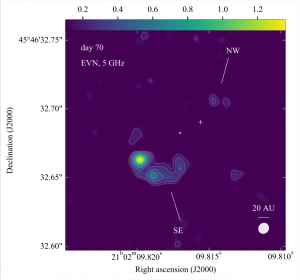
A. VLBI image of V407 Cyg, the first nova detected in gamma rays, as observed 70 days after the outburst with the EVN at 5 GHz
The IRA parabolic antennas in Medicina and Noto are primarily involved in Very Long Baseline Interferometry (VLBI) observations, in combination with other international antennas.
Staff: S. Buttaccio, P. Cassaro, F. D’Ammando, M. Giroletti, E. Liuzzo, G. Maccaferri, M. Negusini, A. Orfei, M. Orienti, A. Orlati, C. Spingola, C. Stanghellini, M. Stagni, T. Venturi
Collaborators: D. Dallacasa, G. Giovannini, R. Ricci
Most of the IRA VLBI activities are conducted through the participation in the EVN Consortium and the worldwide geodetic VLBI network. IRA plays a major role also in the field of design and construction of modern digital backends for VLBI observations, like the te Digital Base Band Converter (DBBC).
VLBI observations with the IRA telescopes are commonly performed by using the e-VLBI technique, which makes use of fibre optics to connect the radio telescopes to the central data processor, allowing for broad-band data transmission and real-time data elaboration. e-VLBI is regularly adopted in EVN experiments as well as for the Italian VLBI observations. In fact, together with the SRT, the Medicina and Noto dishes constitute the Italian e-VLBI network which allows for observations from 1.6 to 26 GHz. The Italian VLBI network is often joined by other telescopes in Europe and East-Asia to increase the sensitivity and resolution capabilities of the array. The geodetic antenna in Matera (property of the Italian Space Agency) also participates in some geodetic Italian VLBI experiments together with the antennas of Medicina and Noto. The realisation of an Italian VLBI array has been made possible also through the expertise in DifX-based software correlation developed at IRA.
The need for distributing frequency reference signals between distant sites without deterioration is an important issue in radio astronomy and geodesy. The availability of fiber optic links between radio observatories and their national metrological institutes has made possible the streaming of extremely stable frequency references. In partnership with the National Timekeeping service, IRA is also involved in a state-of-the art project (LIFT) aimed at using the same fiber optics e-VLBI infrastructure to deliver time and frequency references with extremely high accuracy.
The IRA staff is involved in many VLBI scientific projects mostly focused on the exploitation of the extremely high angular resolution that no other technique can achieve. The main field of interest is the study of the formation and evolution of relativistic jets from supermassive black holes at the center of various classes of Active Galactic Nuclei (radio quiet or radio loud AGNs; young or evolved radio galaxies; gamma-ray blazars; classical radio galaxies). Furthermore, the VLBI technique is applied in studies of galactic systems such as novae and microquasars.
Credits
Main button: EVN
Figure A: Giroletti et al. 2020, A&A 638, A130, “Very long baseline interferometry imaging of the advancing ejecta in the first gamma-ray nova V407 Cygni”, Figure 2. DOI: 10.1051/0004-6361/202038142
